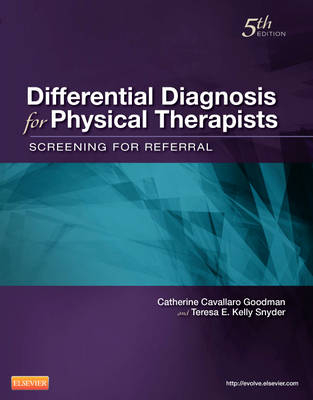
Differential Diagnosis for Physical Therapists
Saunders (Verlag)
978-1-4377-2543-8 (ISBN)
- Titel erscheint in neuer Auflage
- Artikel merken
Written by a leading expert in the field, this comprehensive reference text enables users to properly screen for medical disease to make an informed differential diagnosis. The goal of this text is to teach the Physical Therapist how to determine if the patient has a true neuromuscular or musculoskeletal problem and to determine the specific dysfunction or impairment. This new edition includes a chapter that focuses specifically on pain. It also contains a new chapter on physical assessment as a screening tool and the introductory chapter has been revised to explain the more modern approach of screening.
5-Step screening model for differential diagnosis includes past medical history, risk factor assessment, clinical presentation, associated signs and symptoms, and review of symptoms.
Systems-based approach to the physical therapy screening interview provides a consistent way to screen for systemic disease and medical conditions that can mimic neuromuscular and musculoskeletal problems.
Three sections of content present material in a logical way that covers:
An introduction to the screening process
Viscerogenic causes of neuromusculoskeletal pain and dysfunction
System origins of neuromusculoskeletal pain and dysfunction
Cognitive processing and reasoning orientation approach encourages you to gather and analyze data, pose and solve problems, infer, hypothesize, and make clinical judgments.
Case examples and case studies give real-world examples of hot to integrate screening information into the diagnosis process.
Screening tools in the book and on the Evolve companion website feature forms and checklists used in professional practice.
Introductory information on medical screening concepts set the stage for how screening is presented in the rest of the book.
Reference values for common clinical laboratory tests offer easy access to pertinent information references in a screening exam.
Red flag histories, risk factors, clinical presentation, signs and symptoms, helpful screening clues, and guidelines for referral bring your attention to the important information a therapist needs to be aware of during the screening process.
NEW! Full-color design, photos, and illustrations clearly demonstrate pathologies and processes.
NEW and UPDATED! Evolve resources include printable screening tools and checklists, practice test questions, and more to enhance your learning.
NEW! Hot topics keep you informed on rehabbing patients in the dawn or more current surgeries.
Section One: Introduction to the Screening Process
1. Introduction to Screening for Referral in Physical Therapy
2. Interviewing As a Screening Tool
3. Pain Types and Viscerogenic Pain Patterns
4. Physical Assessment as a Screening Tool
Section Two: Viscerogenic Causes of Neuromusculoskeletal Pain and Dysfunction
5. Screening for Hematologic Disease
6. Screening for Cardiovascular Disease
7. Screening for Pulmonary Disease
8. Screening for Gastrointestinal Disease
9. Screening for Hepatic and Biliary Disease
10. Screening for Urogenital Disease
11. Screening for Endocrine and Metabolic Disease
12. Screening for Immunologic Disease
13. Screening for Cancer
Section Three: Systemic Origins of Neuromusculoskeletal Pain and Dysfunction
14. Screening in the Head, Neck, and Back
15. Screening in the Sacrum, Sacroiliac, and Pelvis
16. Screening in the Lower Quadrant: Buttock, Hip, Thigh, Groin, and Leg
17. Screening in the Chest, Breast, and Ribs
18. Screening in the Shoulder and Upper Extremity
Appendices
A. Screening Summary
B. Special Questions to Ask
C. Special Forms to Use
D. Special Tests to Perform
| Verlagsort | Philadelphia |
|---|---|
| Sprache | englisch |
| Themenwelt | Medizin / Pharmazie ► Physiotherapie / Ergotherapie |
| ISBN-10 | 1-4377-2543-0 / 1437725430 |
| ISBN-13 | 978-1-4377-2543-8 / 9781437725438 |
| Zustand | Neuware |
| Haben Sie eine Frage zum Produkt? |
aus dem Bereich



